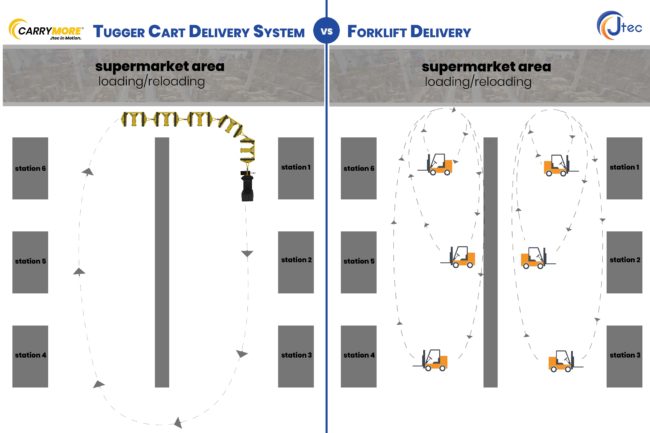Defining Tugging.
A tugger cart system is a group of connected ground-level, heavy-duty carts on casters that carry material from Point A to Point B while being pulled (or “tugged) with a tugger vehicle. This “system” allows a large batch of materials to move in a forward, single-line fashion, thus producing the need for just one trip with multiple deliveries. Implementing tugger cart systems can optimize material flow by decreasing delivery inefficiencies, controlling inventory, and even improving safety.
Implementing a Tugger Cart Train System.
One popular application of a tugger cart train system is the transportation of materials from a loading area to lineside assembly stations. The tugger cart train begins at a supermarket to load up each cart with materials. Once all carts are filled, the train follows a predetermined route along the delivery aisle, stopping only at lineside stations to drop off materials needed for assembly. A train system allows for numerous lineside station deliveries in one trip, unlike other processes that involve many trips. Once deliveries are completed, the train routes back to the loading area to replenish materials and starts the supply run over again.
Forklifts
Currently, a more common approach to moving materials in a facility is forklifts. In a standard manufacturing facility setting, a forklift would make a roundtrip to deliver one pallet or load of material from the supermarket to a lineside station. Then, the forklift travels back to the supermarket to replenish and make another deliver. It repeats this process until all assembly lineside stations are stocked. This process involves several forklifts and several trips to complete all lineside deliveries. This causes downtime while assembly workers wait for their materials to arrive. By running a consistent delivery route with one tugger train and multiple carts, supply-runs are more efficient with reduced downtime. With a tugger cart system, a lineside worker will no longer have to wait for material- unlike downtime during a forklift delivery.
This process also allows more control of inventory. Facilities that use a tugger cart system, move the precise amount of materials needed for that specific assembly, instead of taking up lineside space with multiple containers. This lean technique reduces unnecessary material in the workspace which, in turn, prevents assembly errors while tracking material quality.
The diagram below depicts the downtime and inefficiencies from forklift deliveries, it compares many forklifts making multiple trips (right) to a single tugger cart train delivering to multiple stations in one trip (left).
CarryMore vs Forklift Diagram

View the traffic and delivery efficiencies a tugger cart can provide vs a traditional forklift system.
Forklifts also pose a huge safety hazard, accounting for approximately 85 deaths per year. Statistically, approximately 11% of all forklifts will be involved in an accident over their lifetime. These accidents are costing companies hundreds of thousands of dollars in direct costs. This does not even factor indirect costs such as new labor, training, and loss of experienced workers. These reasons push facilities to look in leaner directions for material handling to improve the safety of their workers and the company’s bottom line.
Tugger cart train systems have been growing in popularity and are slowly becoming the standard in materials movement for manufacturing, warehousing and distribution facilities. This is because of a tugger train’s ability to standardize the materials movement process. By delivering materials and goods consistently, the process improves overall productivity while diminishing safety risks. While introducing a tugger cart system may take some initial reconfiguration of the facility’s current delivery route, the benefits of reduced aisle traffic and increased productivity far outweigh the adjustments required.
Eliminate Time & Strain with Mother/Daughter Carts
There are plenty of options when selecting a tugger train, but one type brings a different approach to lean material handling. A Mother/Daughter cart system consists of two types of carts (a Mother Cart and a Daughter Cart) joining together to create the movement of a material “system”. The Daughter Cart rides on top of the Mother Cart, lifting the daughter cart’s casters completely off the ground. Once a tugger train reaches its location, a Daughter Cart releases from its Mother Cart to deliver materials. It is then loaded back into the Mother Cart and tugged back to the facility’s supermarket to be restocked. This process eliminates time, caster wear and ergonomic strain required to unhitch and re-hitch a standard tugger cart.
Mother/Daughter Carts
Jtec offers multiple standard and custom designs for Daughter Carts, each being made to carry a specific type of material. A Mother Cart can fit multiple styles of Daughter Carts in the same size category, allowing flexibility for each delivery. Mother/Daughter cart systems have multiple advantages over the standard tongue and hitch configuration. These advantages include a reduction in caster wear and noise. It also helps to improve cart maneuverability and delivery speed.
CarryMatic
Some Mother/Daughter cart systems use pneumatic or hydraulic solutions to lift a Daughter Cart onto the Mother Cart. However, from these options stem higher costs and technical issues. Jtec offers a different approach with the CarryMore® Tugger Cart System and its patented technology, Elemate™. This mechanical solution gently loads and unloads Daughter Carts from Mother Carts without the use of hydraulic or pneumatic devices. Instead, Elemate™ uses gravity-assisted mechanisms which cause little to no ergonomic strain on the operator.
Study the comparison chart below to see the differences between a basic tongue and hitch system compared to the CarryMore ® Mother/Daughter Tugger Cart System.

Compare the differences between a Mother/Daughter cart system vs a basic tongue and hitch.
The implementation of a tugger cart system can dramatically improve a facility’s material flow. This should be considered when looking for leaner material handling operations. Contact us today to start your Jtec Journey with the CarryMore® Tugger Cart System.
About Jtec Industries, Inc: Jtec Industries, founded in 2005, is a vertically integrated OEM in Central Illinois that designs and manufactures specialized industrial cart systems to move materials throughout facilities worldwide. Jtec’s award-winning solutions, including the CarryMore® Tugger Cart System and CarryMatic® No-Touch Materials Movement System, improve safety and efficiencies and lower operational costs for materials handling operations.
